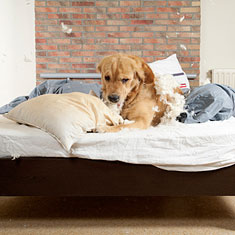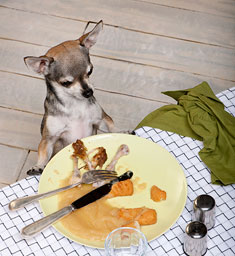Overcoming Your Dog's Behavioral Challenges
Have you ever found yourself saying, "He's a great dog, BUT..."? It seems like most dogs have one or two behavioral issues that drive us batty, even though 99% of the time the dog is the best friend we will ever have. So, how do you help your dog learn the rules of the road for that other 1% of the time?

Decide what you can and cannot live with
You may be one of those lucky people who can live with your dog's behavior issues. However, chances are that each person in your home will have a different idea of what's acceptable and what's not. For example, your 15-year old son may think it's really cool when your Great Dane jumps up to greet him every time he comes home. Your 98-year old grandmother may have a different opinion. As a family, you will need to decide what you can and cannot live with, keeping safety for all household members and visitors in mind.
Start by making a list of the behaviors that each family member finds objectionable. For example, you might include barking at random air molecules, counter-surfing, jumping up, and shredding the toilet paper. Next, have each person rank the behaviors as to how troublesome each of them is. Rankings might depend on such things as the cost of repair or replacement of destroyed items, the inconvenience of clean-up, and the impact of the behavior on people outside your home. For example, if the behavior is that your dog tears up your garbage and drags it around the neighborhood, repair/replacement costs would be low, but the clean-up inconvenience for both you and your neighbors would be high.
Ranking will allow you to focus on the most important behaviors first, then work your way down the list. Anything safety related such as jumping up or biting should be at the top of the list. Choose one behavior to work on first, ignoring the others. When the first behavior is resolved move on down your list.
All family members should be on board with whatever behavior you are tackling so the dog doesn't get mixed messages. If it's only a crime to be on the couch when mom's home, then the dog may have a hard time learning when it's okay and when it's not okay. Consistency is key.
Observe your dog and keep a journal
Once you have decided which behavior to work on first, spend a few days observing your dog to see what brings on the bad behavior. Does the dog chew up the toilet paper only when you leave him alone for a certain number of hours? Does he steal food off of the counter only if you have neglected to fill his food bowl until late in the day? Does the animal bark only at men or people in hats?
Keep a journal, with all family members recording their observations throughout the day. Narrowing down the precursor to the behavior can go a long way in helping you desensitize the dog to whatever sets him off.

Look for ways to minimize stimuli
In a perfect world you would be able to train your dog to simply ignore his bad behavior triggers, but you should also look for ways to minimize your dog's ability to behave badly. For example, if your dog licks your face to wake you up for no reason every night at 2 am, you will want to work on an intervention, but you may also want to shut the bedroom door. If your dog is an inveterate counter-surfer, a baby gate across the kitchen door may be just the ticket.
Positive training works the best
There is no doubt in my mind that you can train any dog to stop any behavior simply by smacking the dog every time he behaves badly. But you will only be training the dog to behave when you're around - out of fear - without giving the animal any incentive to behave. In other words, you will be punishing the dog without teaching him anything. It is far better to teach, making the dog think about the behavior and deciding whether or not to continue that behavior.
It's a gradual process, but one that can produce life-long results. Here's how. Let's say your dog likes to chase your cat. To train the dog positively you might put the dog in a crate and allow the cat into the room. If the dog barks or goes nuts, you will tell him in your best command voice to stop. Eventually, you will find a small window of silence and you can reward the dog with a treat for taking a break.
Reward each step the dog makes toward doing the right thing. In the example of cat chasing, you might reward no barking during successively longer or closer visits from the cat. Once the dog has mastered not reacting to the cat from the safety of his crate, you might put the cat on the other side of a screen door and let the dog out of the crate. Once the dog masters being near the cat without reacting, you might advance to having the cat run across a room, but not necessarily near the dog. If the dog doesn't react, a treat is given. Finally, you might have the cat run right past the dog and if he doesn't react, you give a reward.
Once the dog has mastered the total skill, it's time to make the rewards sporadic. You might reward every other time, or every third time the dog behaves as expected. The dog will continue to perform the right behavior if he knows an occasional reward will be presented. Next, reward the animal at random intervals so he won't be able to guess which time will be rewarded. Sporadic rewards have been shown to produce the most consistent behavior in dogs.
If the dog's performance begins to wane, just step up the reward schedule to reinforce the correct behavior, then slow it back down again as the dog catches on. You may be able to replace reward treats with play time or some other activity that the dog sees as valuable. This can be especially important in small breeds where weight gain is an issue.
Positive training may take a little longer than aversive training, but it is more likely to produce lasting results and a happy dog. Be prepared to consistently persist and your dog will eventually catch on.
Doggies Den: Latest Articles
 Homemade Thanksgiving Treats for Your Dog
Homemade Thanksgiving Treats for Your Dog
NUTRITION We all want to include our dogs in our holiday celebrations, but hopefully, you're aware that sharing table scraps with your dog isn't always the best idea.
 Keeping Your Dog Safe during the Summer Months
Keeping Your Dog Safe during the Summer Months
HEALTH Summer is coming on fast, so it’s time to plan how you will keep your dog safe and healthy through the lazy, carefree, warm days.
 Vaccination Time Again-Keeping Your Puppy Healthy
Vaccination Time Again-Keeping Your Puppy Healthy
DOG HEALTH So you have your new puppy picked out. There are quite a few shots, treatments and examinations that will keep the newest member of your family healthy.
 Canine Thanksgiving Feast
Canine Thanksgiving Feast
NUTRITION With the wide variety of food at Thanksgiving dinner, chances are you'll want to give your dog something special, too. If you're contemplating what to feed your dog for the holiday, here is a guide to a great Canine Thanksgiving Feast.
 Dog Walking Tips Every Owner Should Know
Dog Walking Tips Every Owner Should Know
DOG FUN Walking your dog is not only crucial to keeping him healthy and happy, it strengthens the bond between your canine friend and his caregiver. There are a lot of obstacles out there. Don’t forget these simple tips to keep your walk fun and safe in the outside world.
 The Benefits of Physiotherapy for your Dog
The Benefits of Physiotherapy for your Dog
HEALTH The same techniques that physiotherapists use to treat a variety of injuries and conditions in humans have been adapted to suit animals with great success. Family pets, show dogs, and working dogs can all benefit greatly from physiotherapy. Dogs whose activities involve a lot of agility are especially susceptible to the types of problems that physiotherapy can address.
 The Decision- Adding a Dog to Your Family
The Decision- Adding a Dog to Your Family
FIRST TIME OWNERSBringing a dog into your family is a decision where many people don’t realize it’s magnitude until after they have the dog. There are a number of things that you need to research before you decide to purchase a dog, and it starts right in your own home.
 Bringing Your Dog Into Your New Baby's Life
Bringing Your Dog Into Your New Baby's Life
HEALTH Many believe that a dog and a new baby cannot happily coexist, so therefore the dog has to go. This is not necessarily the case.  A new baby does not mean you have to abandon your dog.

Doggies Den:
Most Popular Articles

Dog Pregnancy Symptoms
HEALTHIf you suspect your dog might be pregnant, check out part one in this series on pregnant dogs, where we cover pregnant dog symptoms.

Dog Birth
HEALTHIn the third article of our dog pregnancy series, we look at the wonderful, but messy, process of bringing newborn puppies into the world.

Indoor Dog Potties
DOG PRODUCTSIt's been a long day at work. You were so busy, you didn't even take time to eat a sandwich, let alone run home to let your dog out. You're on your way home, knowing the poor dog is crossing his or her legs by now, when your car breaks down, delaying you even further. Can't somebody make this easier?

Your Dog’s Digestive System
PHYSIOLOGYEver wonder why your dog eats so fast? Or why he eats gross things? Or why he gets sick to his stomach? Or why his waste stinks so bad? Some of these things are normal, some are not.

Canine Respiratory System
BREATHINGThe basic function of your dog's respiratory system is to bring oxygen in to and remove carbon dioxide from the body. Knowing the symptoms of respiratory diseases can help you help your stay healthy.

Shelter Dog Adoption Tips for Success
ADOPTION Are you intimidated by the prospect of "rescuing" a dog from a shelter? One reason that you may be wary of adopting a dog from a shelter is not knowing how to choose. Adopting a dog from a shelter can be a rewarding process, if you're prepared to do a reasonable amount of research.

Canine Urinary Tract Infections
SYMPTOMS AND TREATMENTDoes your dog seem to be having trouble relieving his or her bladder? Learn how to recognize the signs of urinary tract infections and how to treat them before they spread.

What to do for Dog Diarrhea
SYMPTOMS AND REMEDIESIf you have dogs in your house for any length of time, you have likely experienced at least one bout of dog diarrhea. Beyond the pain in the tuckus involved in cleaning up the mess, you should know what causes diarrhea, and when it's important to see the vet.

What to do for a Dog Bite
DOG BEHAVIOR Getting bitten by a dog can be scary, and you may be tempted to run around in circles for a while, trying to figure out what to do. Here's our guide to help you manage the situation.

Top Ten Tips for Living with a Senior Dog
DOG HEALTH Bringing home a new puppy is so exciting, but it doesn’t take all that long for your exuberant puppy to grow into a senior dog who may have special needs. Here are the doggies.com top ten tips for taking care of your companion who has been with you through so much.
